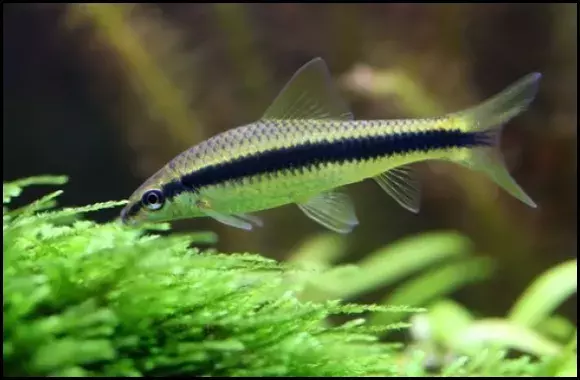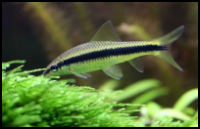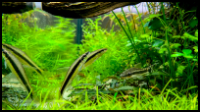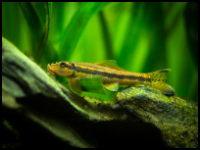





Quick Care Details (Table)
| Livestock Characteristics | Value |
|---|---|
| Care Level | Moderate |
| Temperament | Peaceful |
| Diet | Omnivore |
| Maximum Size | 6 Inches |
| Minimum Tank Size | 30 Gallons |
| Plant Safe | Yes |
| Temperature Range | 75-78F |
| PH Range | 6.5-7.0 |
| KH Range | 5-10 |
Species Specific Categories
Helpful Video
Care Details
Aquascape: When creating an ideal habitat for Siamese Algae Eaters, envision a setup that mimics their natural environment. Dense vegetation, driftwood, and rock formations provide hiding spots and mimic the riverbanks they inhabit in the wild. The addition of live plants, like Java fern or Anubias, can serve as a supplemental food source and make your tank feel like home.
Substrate: A sandy or fine gravel substrate is preferable for these bottom-dwelling fish. It closely resembles the riverbeds they inhabit in Southeast Asia, where they forage for food. A soft substrate will protect their barbels and provide a more comfortable environment.
Disease Prevention: Preventing disease is key to the well-being of Siamese Algae Eaters. Ensure their tank is well-maintained with regular water changes and optimal water quality. Quarantine new fish additions to prevent the introduction of diseases into your main tank.
Filtration: Invest in a reliable filter system to keep the water clean and well-oxygenated. Siamese Algae Eaters prefer moderate water flow, so position the filter outlets to provide gentle currents in their habitat.
Lighting: Siamese Algae Eaters don't have specific lighting requirements. Standard aquarium lighting is usually sufficient. However, consider a natural lighting cycle to support the growth of algae for their consumption.
Water Flow: As mentioned earlier, moderate water flow is suitable. Siamese Algae Eaters come from rivers and streams with gentle currents, so aim to replicate this environment in your tank.
Hardiness: These fish are known for their hardy nature. They can tolerate a range of water parameters, making them suitable for both beginner and experienced aquarists.
Acclimation: When introducing Siamese Algae Eaters to your tank, acclimate them gradually to prevent shock. Float the bag in the tank to equalize temperatures before releasing them.
Expected Lifespan: With proper care, Siamese Algae Eaters can live for several years, often reaching a lifespan of 5 to 7 years in well-maintained aquariums.
Special Requirements: Siamese Algae Eaters primarily feed on algae, so ensure there's a natural algae source in the tank. If algae growth is insufficient, supplement their diet with algae wafers and sinking pellets. Additionally, they are social fish and thrive in small groups, so consider keeping them with at least two or three companions.
Temperament and Behavior
Behavior: Siamese Algae Eaters are nature's clean-up crew in the aquarium world. These diligent little fish are known for their voracious appetite for algae, making them excellent tank mates for aquarists looking to keep their tanks sparkling clean. They're active, agile, and can often be seen darting around the tank, tirelessly nibbling on algae and leftover food.
Breeding: Breeding Siamese Algae Eaters in captivity can be challenging. They are egg layers, and unlike some fish, they don't readily reproduce in home aquariums. Successful breeding usually involves simulating their natural habitat, which includes clear, flowing water with a sandy substrate. Rearing their fry can also be tricky due to their small size and specific dietary needs.
Aggression: Siamese Algae Eaters are relatively peaceful fish. However, they can become territorial when it comes to their food source. It's a good idea to provide multiple feeding areas in the tank to prevent disputes. They are not known to be aggressive toward other fish or each other.
Tankmates Compatibility: Siamese Algae Eaters are excellent community fish. They peacefully coexist with a wide range of tankmates, including other peaceful community fish, such as tetras, rasboras, and peaceful catfish. Just be cautious when housing them with slow-moving or long-finned fish, as they may mistake their fins for food.
Activity Level: These little workers are always on the move, patrolling your tank for algae. Their constant activity adds dynamism to your aquarium, making them a lively and entertaining addition.
Schooling or Shoaling Behavior: Siamese Algae Eaters are often seen in small groups. They exhibit shoaling behavior, which means they like the company of their own kind. Keeping them in a group of three or more enhances their well-being and reduces stress.
Plant Compatibility: Siamese Algae Eaters generally won't devour your aquatic plants. They are focused on algae as their primary food source. In fact, their presence can help maintain a healthy balance in a planted tank by keeping unsightly algae growth in check.
Diet and Nutrition
Dry Foods: Siamese Algae Eaters readily accept high-quality dry foods such as algae wafers and sinking pellets. These are convenient options that provide essential nutrients while helping maintain their health and vibrant coloration.
Frozen Foods: While they primarily feed on algae, Siamese Algae Eaters can occasionally enjoy frozen foods like brine shrimp, bloodworms, and daphnia as a tasty treat. These protein-rich options can be provided as a supplement to their diet.
Live Foods: Siamese Algae Eaters have a preference for live foods, especially in their juvenile stages. Offering them live foods like small insects, mosquito larvae, or daphnia can be a real treat and can be particularly beneficial for younger individuals.
Vegetables: Fresh vegetables are a fantastic addition to their diet. Blanched vegetables like zucchini, cucumber, and spinach are relished by Siamese Algae Eaters. Attach these veggies to a weight and place them in the tank for your fish to graze on.
Algae: Naturally, Siamese Algae Eaters love to munch on the algae that grow in your aquarium. They play a valuable role in algae control, so maintaining a balance of algae growth is crucial to their diet.
Feeding Schedule: These fish are active eaters, so you can feed them once or twice a day. Offer a small amount of food that they can consume in a few minutes to prevent overfeeding, which can lead to water quality issues.
Supplemental Foods: To ensure they receive a well-rounded diet, consider providing supplemental foods like high-quality algae wafers and sinking pellets. These items are formulated to meet their dietary needs and promote their overall health.
Tank Parameters
Tank Size: Siamese Algae Eaters are quite active, so you'll want to offer them a space where they can stretch their fins. A 20-gallon tank is a good starting point, but if you have a larger group, consider upgrading to a bigger tank to give them room to roam.
Tank Length and Measurements: The tank's length matters because these fish enjoy horizontal swimming. Opt for a tank that's at least 24 inches long to accommodate their active lifestyle. The width and depth should provide enough space for them to move around comfortably.
Water Temperature: Think of Siamese Algae Eaters as your tropical pals. They prefer water temperatures between 75°F and 79°F (24°C to 26°C). Maintaining a stable temperature in this range keeps them content.
pH (Acidity/Alkalinity): Siamese Algae Eaters aren't too fussy about pH levels. They thrive in water with a pH ranging from slightly acidic to slightly alkaline, typically between 6.5 and 7.5.
KH (Carbonate Hardness) and GH (General Hardness): These parameters can vary a bit, but aim for a carbonate hardness (KH) between 2 to 10 degrees and a general hardness (GH) of 5 to 15 degrees. This closely resembles their native habitat conditions.
Hardiness: Siamese Algae Eaters are known for their resilience. They can handle a range of water conditions, which makes them a solid choice for aquarium enthusiasts of all experience levels.
Nitrate (NO3) Levels: Maintaining nitrate levels below 20 ppm is a good rule of thumb. Regular water changes and efficient filtration are your allies in achieving and sustaining this balance.
History, Popularity, History and Species Variety Details
History: The Siamese Algae Eater, scientifically known as Crossocheilus oblongus, has a storied history in the aquarium world. Native to Southeast Asia, they've been cherished for decades due to their exceptional algae-eating abilities. Initially, they were confused with the Flying Fox species due to their similar appearance. These fish have been a reliable ally for aquarists battling unwanted algae in their tanks.
Popularity: Siamese Algae Eaters have gained a strong following among aquarists for their efficient algae control and peaceful nature. They're a must-have for any aquarist struggling with algae issues. Their popularity extends to both beginners and experienced hobbyists who appreciate their contribution to maintaining a clean and balanced aquarium environment.
Natural Habitat: In their native habitat of Southeast Asia, Siamese Algae Eaters are typically found in freshwater rivers and streams. These waters are rich in vegetation and provide a diverse range of algae for them to feed on. Their natural environment has shaped their behavior and dietary preferences, making them excellent algae-eating companions for your home aquarium.
Understanding the historical background, widespread popularity, and natural origins of Siamese Algae Eaters sheds light on why they're a valuable addition to many aquariums, helping to keep unwanted algae growth in check.
Variations of the Siamese Alage Eater
- True Siamese Algae Eater (Crossocheilus siamensis): This is the most recognized and commonly available species. It's known for its distinctive black horizontal stripe running the length of its body. This stripe tends to fade as the fish matures.
- False Siamese Algae Eater (Crossocheilus oblongus): The False Siamese Algae Eater is often confused with its true counterpart. It lacks the distinctive black stripe and has a more elongated body. While it consumes algae, it's not as effective as the true Siamese Algae Eater.
- Crossocheilus reticulatus: This species has a more intricate pattern of stripes and a longer body. It's not as commonly seen in the aquarium trade as the true Siamese Algae Eater.
- Crossocheilus langei: Also known as Lange's Algae Eater, this species features a unique spotted pattern along its sides. It's less common in the aquarium trade but shares a similar appetite for algae.
- Albino Siamese Algae Eater: These are normally the same as regular Siamese Algae Eaters but white skin pigmentation.
Frequently Asked Questions
Are Siamese Algae Eaters suitable for beginners?
Yes, they are a great choice for both beginners and experienced aquarists due to their hardiness and effectiveness at controlling algae.
Can Siamese Algae Eaters eliminate all algae in my tank?
While they're excellent algae eaters, they may not completely eradicate all types of algae. Regular tank maintenance and a balanced approach are key to a thriving, algae-free environment.
Are Siamese Algae Eaters compatible with plants?
Yes, they generally won't harm live plants and can be a useful addition to an aquarium with a planted setup.
How do I feed Siamese Algae Eaters if there isn't enough algae in my tank?
They'll gladly accept high-quality flake or pellet foods. While these are not their primary diet, they can help supplement their nutrition if algae is scarce.
Do Siamese Algae Eaters breed in home aquariums?
While they can breed in captivity, it's not as common, and breeding them can be a bit challenging. Most Siamese Algae Eaters available in the aquarium trade are wild-caught.
How many Siamese Algae Eaters should I keep in my tank?
It's best to keep them in small groups, around three to six, as they tend to be more active and comfortable in the company of their own kind.
What are the ideal water parameters for Siamese Algae Eaters?
They prefer a temperature range of 75°F to 79°F (24°C to 26°C) and a pH between 6.5 and 7.5. They're quite adaptable and can handle a range of water conditions.
Can I keep Siamese Algae Eaters with other fish?
Yes, Siamese Algae Eaters are generally peaceful and can coexist with a variety of community fish. Just make sure their tankmates aren't aggressive or too large to bully them.
What kind of algae do Siamese Algae Eaters eat?
Siamese Algae Eaters are not picky eaters when it comes to algae. They'll happily munch on various types of algae, including green algae, brown diatoms, and even the stubborn black beard algae.
What is a Siamese Algae Eater, and why should I consider adding it to my aquarium?
A Siamese Algae Eater is a small, sleek fish with a black stripe along its body. It's a fantastic addition to your aquarium because it's a voracious algae-eater, helping to keep your tank clean and free from unwanted algae growth.

